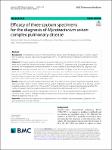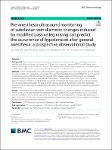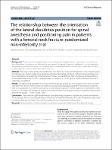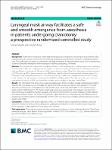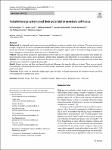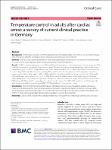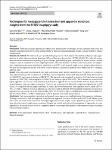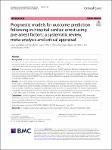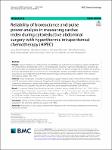Search
Author
- Osman, Ahmed I. (5)
- Daqing, Ma (3)
- Jorgensen, Ed (3)
- Li, Yan (3)
- next >
Subject
- kinh tế (26)
- Economics (12)
- programming (10)
- XRD (10)
- next >
Date issued
- 2020 - 2025 (2129)
- 2010 - 2019 (129)
- 2000 - 2009 (9)
- 1999 - 1999 (1)
Has File(s)
Search Results
In Mycobacterium avium complex pulmonary disease (MAC-PD), diagnosis requires a positive culture from at least two separate expectorated sputum specimens. The optimal number of sputum examinations remains unclear. |
Perioperative hypotension increases postoperative complication rates and prolongs postoperative recovery time. Whether Passive Leg Raising test (PLR) and Subclavian Vein Diameter (DSCV) can effectively predict post-anesthesia hypotension remains to be tested. This study aimed to identify specific predictors of General Anesthesia (GA)induced hypotension by measuring DSCV in the supine versus PLR position. |
To date, no clinical studies have investigated the relationship between positioning pain and orientation of the lateral decubitus position for hip fracture surgery. The aim of the present study was to test the hypothesis that performing spinal anesthesia in the lateral decubitus position with the fracture side up or down does not affect positioning pain in patients with a femoral neck fracture. |
Endotracheal extubation under deep anesthesia (deep extubation) has been proved to present stable hemodynamics and steady intracranial pressure during emergence from anesthesia in patients undergoing craniotomy. This study aims to examine, in comparison with deep extubation, if a laryngeal mask airway (LMA) could provide a safer and smoother emergence from anesthesia in patients undergoing craniotomy. |
In orthopedic and trauma surgery, pulsatile lavage systems are used to clean soft tissue. This may be necessary in septic surgeries or in case of contaminated wounds after trauma. Positive features such as reduction of bacterial contamination and removal of foreign particles are counterbalanced by negative aspects such as bacterial seeding in deeper tissue layers, damage to various tissues and even cases of air embolism. |
Temperature control in adults after cardiac arrest: a survey of current clinical practice in Germany Temperature control is recommended after out of hospital cardiac arrest (OHCA) by international guidelines. This survey aimed to investigate current clinical practice and areas of uncertainty. |
urgically managed appendicitis exhibits great heterogeneity in techniques for mesoappendix transection and appendix amputation from its base. It is unclear whether a particular surgical technique provides outcome benefit or reduces complications. |
Several prediction models of survival after in-hospital cardiac arrest (IHCA) have been published, but no overview of model performance and external validation exists. We performed a systematic review of the available prognostic models for outcome prediction of attempted resuscitation for IHCA using pre-arrest factors to enhance clinical decision-making through improved outcome prediction. |
Frustration, which is one aspect of the field of emotional recognition, is of particular interest to the video game industry as it provides information concerning each individual player’s level of engagement. The use of non-invasive strategies to estimate this emotion is, therefore, a relevant line of research with a direct application to real-world scenarios. While several proposals regarding the performance of non-invasive frustration recognition can be found in literature, they usually rely on hand-crafted features and rarely exploit the potential inherent to the combination of different sources of information. This work, therefore, presents a new approach that automatically extracts meaningful descriptors from individual audio and video sources of information using Deep Neural N... |
Various malignancies with peritoneal carcinomatosis are treated with cytoreductive surgery and hyperthermic intraperitoneal chemotherapy (HIPEC). The hemodynamic instability resulting from fluid balance alterations during the procedure necessitates reliable hemodynamic monitoring. The aim of the study was to compare the accuracy, precision and trending ability of two less invasive hemodynamic monitors, bioreactance-based Starling SV and pulse power device LiDCOrapid with bolus thermodilution technique with pulmonary artery catheter in the setting of cytoreductive surgery with HIPEC. |

